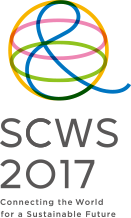English │ Español
By Elis Monroy
MIDE, Museo Interactivo de Economía
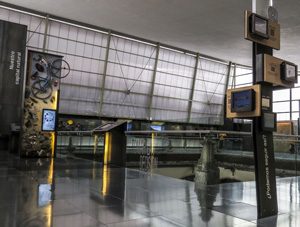 What’s the use of science museums? Surely there are hundreds of answers to this question, but if we investigate as children do, asking one “Why?” after another, it’s certain that sooner or later, the welfare of the people will be mentioned. And it is not surprising, since this has been one of the arguments by which science itself has earned the trust and financing to become the great “company” we know today.
What’s the use of science museums? Surely there are hundreds of answers to this question, but if we investigate as children do, asking one “Why?” after another, it’s certain that sooner or later, the welfare of the people will be mentioned. And it is not surprising, since this has been one of the arguments by which science itself has earned the trust and financing to become the great “company” we know today.
Currently, there are hundreds of science museums of all sizes and themes, scattered all around the world. They respond to the growing evidence about the importance of creating spaces where people can meet and interact with scientific principles and mechanisms that explain some of the most important factors in our lives, such as health, communication, and food security, among many others. Gladly, we have seen that the appearance of these museums responds to the need of having the opportunity to develop tools to make responsible decisions at a personal and collective level, and this is where the importance of acting together manifests.
In the Interactive Museum of Economics (MIDE), the first in the world to specialize in the communication of this science, we realized that communicating the most basic principles of the economy without incorporating their relationship to society and the environment represented a weakness in our speech. Therefore, in 2011 we opened our room Sustainable Development: Economy, Society and Nature in which we show how our decisions regarding consumption and production of goods and services directly impact the well-being of the planet and society, as well as the many alternatives we have to rethink the role we play in these processes.
It is from this learning that we are convinced that science museums must help address a sustainable approach to communicating a more comprehensive and inclusive vision of the world we inhabit. Adopting this approach opens the possibility of glimpsing the challenges we face as a global community, of thinking about relevant solutions to the environmental problems we are experiencing, and of engaging with the decisions and actions required to build a more just and equitable world.
Last year, 175 United Nations member countries decided to join efforts again to address the most pressing needs of humanity, and created 17 Sustainable Development Goals (SDGs). These goals resemble the Millennium Development Goals, drafted in 2000, but also incorporate new challenges which address the quality of life of the population, the welfare of many ecosystems around the world, and the continuity of economic processes.
There are many ways of interpreting the rethinking of the goals, but certainly the most important concerns a second attempt to correct the course of our goals and decisions, encouraging more and more sectors of society to commit to joining efforts to achieve significant changes in the next 15 years.
The need to address the 17 SDGs from all possible trenches caused them to be written in such a way that they are easily communicable and inclusive. They relate to familiar issues such as food security, clean water, and the welfare of the oceans, issues in which science is clearly invested and about which awareness is critical.
Achieving these SDGs requires the joint effort of all sectors comprising society and, of course, centers and science museums. While each museum has a particular subject or approach, the transformational capacity by leveraging this diversity in a joint strategy represents an unprecedented potential, such as the one needed to give the necessary push to the SDGs.
Those who inhabit the world are in a moment similar to the one in which an athlete finds him or herself before a competition to determine who gets the gold medal in his or her last Olympics. They take their position, then align their mind, breath, and every one of their muscles to achieve the challenging target in front of them. Just like that, today we have to align our efforts to achieve a goal, rather, to achieve the 17 Sustainable Development Goals, to ensure not a gold medal, but a dignified survival in our planet.
Objetivos de desarrollo sostenible en los museos de ciencia
Por Elis Monroy García
MIDE, Museo Interactivo de Economía
 ¿Para qué sirven los museos de ciencias? Seguramente existen cientos de respuestas a esta pregunta; pero si investigáramos como lo hacen las niñas y los niños, preguntando un por qué tras otro, es seguro que en algún momento se mencionaría el bienestar de las personas. No debería sorprendernos, ya que éste ha sido uno de los argumentos por los cuales la ciencia misma ha merecido la confianza y el financiamiento para llegar a ser la enorme empresa que hoy conocemos.
¿Para qué sirven los museos de ciencias? Seguramente existen cientos de respuestas a esta pregunta; pero si investigáramos como lo hacen las niñas y los niños, preguntando un por qué tras otro, es seguro que en algún momento se mencionaría el bienestar de las personas. No debería sorprendernos, ya que éste ha sido uno de los argumentos por los cuales la ciencia misma ha merecido la confianza y el financiamiento para llegar a ser la enorme empresa que hoy conocemos.
Actualmente, existen cientos de museos de ciencia, de todos tamaños y temas, esparcidos por el mundo entero. Y es que cada vez se hace más evidente la importancia de crear espacios en donde la gente se pueda acercar a conocer e interactuar con los principios y mecanismos científicos que explican algunos de los factores más importantes de nuestras vidas, como la salud, la comunicación y la seguridad alimenticia, entre muchos otros. Con gusto, hemos visto que la aparición de estos museos responde a la necesidad de que las personas cuenten con la oportunidad de conocer herramientas para tomar decisiones responsables a nivel personal y colectivo; y es aquí en donde se manifiesta la importancia de actuar de manera conjunta.
En el Museo Interactivo de Economía (MIDE), el primero del mundo en especializarse en la divulgación de esta ciencia, nos dimos cuenta de que comunicar los principios más elementales de la economía, sin incorporar la relación que guardan con la sociedad y el medio ambiente, representaba una debilidad en nuestro discurso. Por lo tanto, en 2011 inauguramos nuestra sala Desarrollo Sustentable: Economía, Sociedad y Naturaleza, en la que mostramos cómo nuestras decisiones respecto al consumo y producción de bienes y servicios impactan directamente en el bienestar del planeta y de la sociedad, así como las numerosas alternativas que tenemos para replantear el papel que jugamos dentro de estos procesos.
A partir de este aprendizaje estamos convencidos de la importancia de que los museos de ciencia retomen el enfoque de sostenibilidad para comunicar una visión más completa e incluyente del mundo en el que vivimos. Adoptar este enfoque abre la posibilidad de vislumbrar los retos que enfrentamos como comunidad global, de pensar en soluciones pertinentes a los problemas ambientales que estamos viviendo y de comprometernos con las decisiones y acciones que se requieren para construir un mundo más justo y equitativo.
El año pasado, los 175 países integrantes de la ONU ratificaron su decisión de unificar esfuerzos para atender las necesidades más apremiantes de la humanidad, y se plantearon diecisiete Objetivos del Desarrollo Sostenible (ODS). Éstos retoman los Objetivos de Desarrollo del Milenio, redactados en el año 2000, pero también incorporan nuevos retos a los que se enfrentan los países, incluido el nuestro, y que comprometen la calidad de vida de la población, así como el bienestar de diversos ecosistemas alrededor del mundo y la continuidad de los procesos económicos.
Hay muchas formas de interpretar el replanteamiento de estos Objetivos; pero, sin duda, la más importante se refiere a un segundo intento para corregir el rumbo de nuestras metas y decisiones, promoviendo que cada vez más sectores de la sociedad se comprometan a sumar esfuerzos para lograr cambios significativos en los siguientes quince años.
La necesidad de que los diecisiete ODS sean atendidos desde todas las trincheras posibles hizo que fueran redactados de forma sencilla y clara. Se refieren a temas familiares, como las necesidades de atender la seguridad alimenticia, contar con agua limpia, o asegurar el bienestar de los océanos; temas en los que la ciencia está claramente inmiscuida y cuya concientización es fundamental para enfrentarlos.
Lograr estos ODS requiere del esfuerzo en conjunto de todos los sectores de la sociedad y, por supuesto, de los centros y museos de ciencia. Si bien cada museo cuenta con una aproximación o temática particular, la capacidad de transformación al aprovechar esta diversidad en una estrategia conjunta representa un potencial sin precedentes, tal como el que se necesita para dar el empuje necesario a los ODS.
Quienes habitamos el mundo nos encontramos en un momento parecido al de un atleta antes de la competencia que determina quién se lleva la medalla de oro de su última olimpiada. El atleta toma su posición, se prepara y entonces su mente, su respiración y cada uno de sus músculos se alinean ante el desafío que tiene enfrente. Así, hoy necesitamos alinear nuestros esfuerzos para lograr los 17 Objetivos del Desarrollo Sostenible y asegurar no una medalla de oro, sino una supervivencia digna en nuestro único planeta.
English │ Español
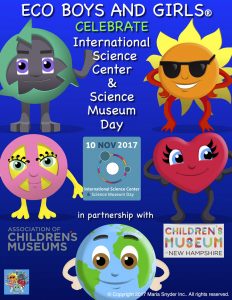 Eco Boys and Girls join with the Association of Science-Technology Centers to celebrate the 2017 International Science Center and Science Museum Day (ISCSMD 2017). As a children’s media company reaching young children across the globe with educational programming focused on early science, sustainable development, and respect for diversity through pluralism, being among leaders in science education and innovation is an exciting opportunity to learn from other dedicated professionals in this field.
Eco Boys and Girls join with the Association of Science-Technology Centers to celebrate the 2017 International Science Center and Science Museum Day (ISCSMD 2017). As a children’s media company reaching young children across the globe with educational programming focused on early science, sustainable development, and respect for diversity through pluralism, being among leaders in science education and innovation is an exciting opportunity to learn from other dedicated professionals in this field.
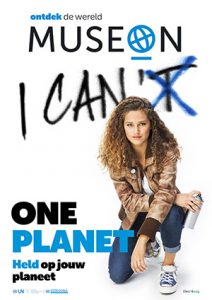 The new, action-oriented exhibition
The new, action-oriented exhibition 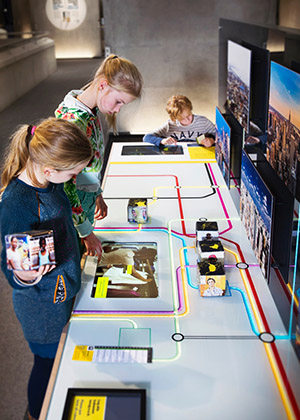 One Planet offers visitors a series of seventeen displays, each examining a different SDG and together encompassing the major challenges facing humankind today. The interactive displays are presented in combination with items from the Museon’s multifaceted educational collection. The exhibition focuses on the many kinds of action that can be taken to guarantee the sustainability of life on Earth. From dramatic, large-scale solutions to modest ideas that impact on a single square metre, One Planet makes it clear to visitors that they have a part to play and inspires them to think further about the problems and how to help solve them.
One Planet offers visitors a series of seventeen displays, each examining a different SDG and together encompassing the major challenges facing humankind today. The interactive displays are presented in combination with items from the Museon’s multifaceted educational collection. The exhibition focuses on the many kinds of action that can be taken to guarantee the sustainability of life on Earth. From dramatic, large-scale solutions to modest ideas that impact on a single square metre, One Planet makes it clear to visitors that they have a part to play and inspires them to think further about the problems and how to help solve them.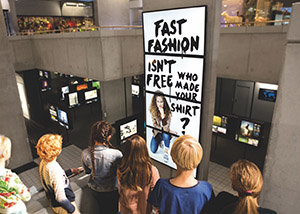 The Museon is a lively social hub in The Hague, the International City of Peace and Justice. As a museum with a go-ahead, inclusive image and approach, the Museon makes it part of its mission to bridge the gap between the international city on the one hand and “ordinary” citizens on the other. For that reason, its programming reflects the international character of the city and aims to help the general public understand The Hague’s global ambitions. This is immediately clear as soon as visitors enter the building and find themselves in the International Lounge. The area serves as a meeting place and links the Museon intellectually to The Hague’s International Zone and the themes of peace and justice. The lounge is a platform for trailblazing initiatives in the field of peace and justice, such as
The Museon is a lively social hub in The Hague, the International City of Peace and Justice. As a museum with a go-ahead, inclusive image and approach, the Museon makes it part of its mission to bridge the gap between the international city on the one hand and “ordinary” citizens on the other. For that reason, its programming reflects the international character of the city and aims to help the general public understand The Hague’s global ambitions. This is immediately clear as soon as visitors enter the building and find themselves in the International Lounge. The area serves as a meeting place and links the Museon intellectually to The Hague’s International Zone and the themes of peace and justice. The lounge is a platform for trailblazing initiatives in the field of peace and justice, such as 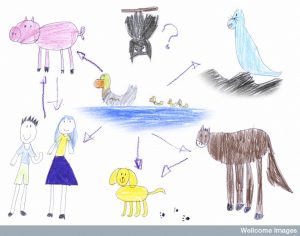 The
The  What’s the use of science museums? Surely there are hundreds of answers to this question, but if we investigate as children do, asking one “Why?” after another, it’s certain that sooner or later, the welfare of the people will be mentioned. And it is not surprising, since this has been one of the arguments by which science itself has earned the trust and financing to become the great “company” we know today.
What’s the use of science museums? Surely there are hundreds of answers to this question, but if we investigate as children do, asking one “Why?” after another, it’s certain that sooner or later, the welfare of the people will be mentioned. And it is not surprising, since this has been one of the arguments by which science itself has earned the trust and financing to become the great “company” we know today. Future Earth fully supports UNESCO’s and the international network of science centres’ initiative to support the Sustainable Development Goals. The SDGs mark a paradigm shift in human development. They are the first acknowledgement that global sustainability is now a prerequisite for human welfare and prosperity – and global sustainability is at risk. To succeed, the goals must reach every man, woman and child. The world’s science centres and museums have a critical role to engage the public in the goals. We wish you every success!
Future Earth fully supports UNESCO’s and the international network of science centres’ initiative to support the Sustainable Development Goals. The SDGs mark a paradigm shift in human development. They are the first acknowledgement that global sustainability is now a prerequisite for human welfare and prosperity – and global sustainability is at risk. To succeed, the goals must reach every man, woman and child. The world’s science centres and museums have a critical role to engage the public in the goals. We wish you every success!